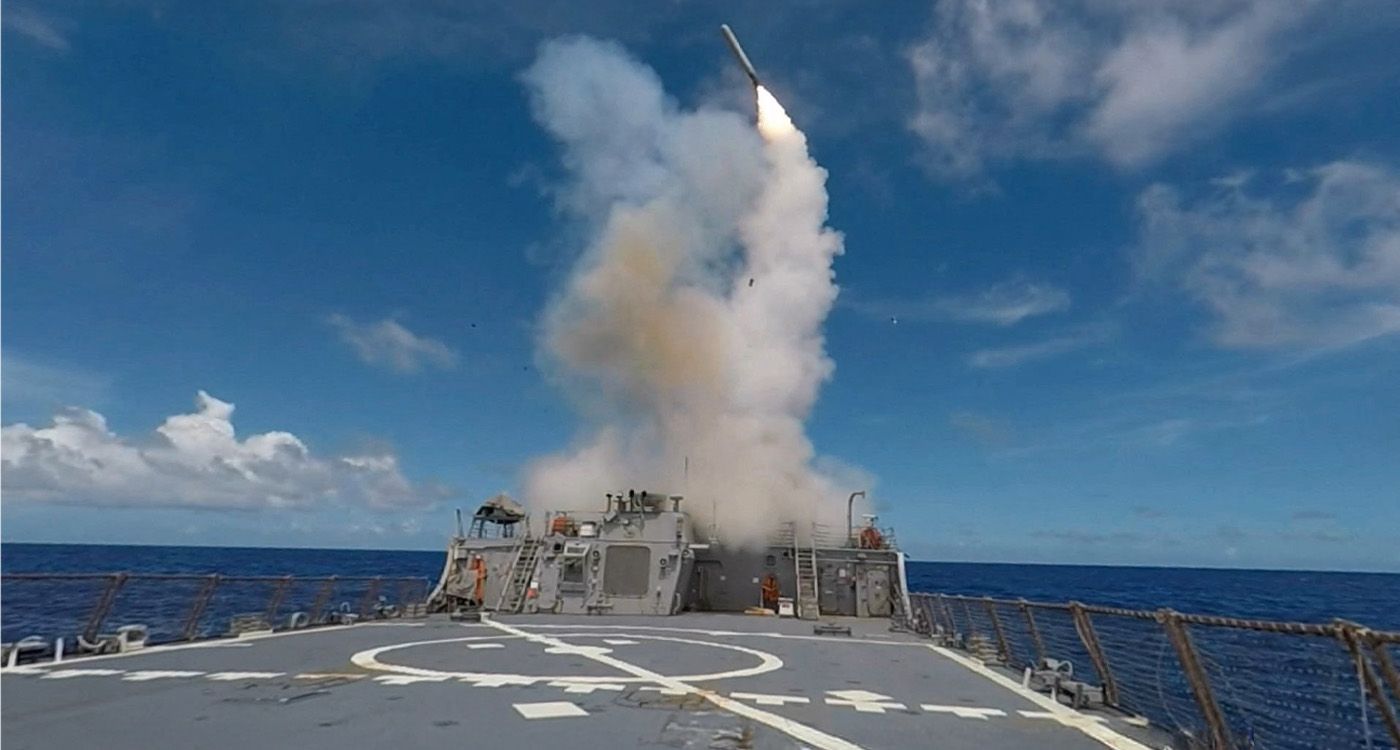- Home
- Middle East
- Could US Tomahawk Missiles Shift the Balance in Ukraine?

A Tomahawk missile is launched from the Arleigh Burke-class guided-missile destroyer USS Stethem during the biennial Valiant Shield field training exercise on September 20, 2016. The United States launched “dozens of Tomahawk cruise missiles” at Syrian air bases, according to US officials, on April 6, 2017. ©Jarret Morris / US Navy / AFP
As the war in Ukraine enters its fourth year, the prospect of US Tomahawk missiles reaching Kyiv raises both hope and caution. For some, these iconic precision weapons could give the Ukrainian military a strategic edge against a fatigued Russia. For others, they are chiefly a political signal aimed at shaping future negotiations. Could these missiles truly tip the balance of the conflict?
A Long‑Range Precision Weapon
The Tomahawk is a subsonic cruise missile in service for over 40 years. Designed for launch from ships or submarines, it can travel up to 1,600 kilometers at roughly 880 kilometers per hour, flying low to evade radar. According to US Navy budget documents cited by AFP, nearly 8,959 Tomahawks have been produced, with more than 2,350 fired since the Gulf War in 1991. A nuclear variant existed until its retirement in 2013.
The latest, fifth‑generation version, deployed since 2021, can be retargeted mid-flight. Each missile costs around $2.5 million and carries a 450‑kilogram warhead, capable of striking hardened infrastructure, including airbases, command centers, air-defense batteries and other strategic sites.
A Potential Strategic Advantage for Kyiv
For Ukraine, the Tomahawk’s greatest asset is its range, roughly five times that of the ATACMS surface‑to‑surface missile system supplied by Washington since 2023. The Institute for the Study of War (ISW) estimates Kyiv could target over 1,600 sites in Russia, including dozens of airbases well beyond Moscow.
This deep‑strike capability would allow Ukrainian forces to hit logistics hubs and command centers without entering Russian airspace. Careful deployment could force Moscow to spread its air defenses, reorganize command networks and allocate more resources to protecting its territory. In a war already costly for Russia, these shifts would themselves represent a strategic gain for Kyiv.
Major Logistical and Industrial Constraints
Ukraine’s ambitions face significant industrial and logistical hurdles. Stacie Pettyjohn of the Center for a New American Security (CNAS), cited by AFP, notes that the United States does not have unlimited Tomahawk stocks: the Navy has only ordered 57 missiles for 2026, too few for mass production by Raytheon.
The challenge is compounded by launch systems. The Tomahawk is designed for maritime deployment, while the US military has only a handful of land-based launchers. Adapting the system for Ukraine would require extensive training, technical support and security guarantees, delaying any practical deployment.
Ukraine’s Growing Strike Capabilities
Even without Tomahawks, Ukraine has steadily expanded its long-range strike arsenal. According to General Schill, Ukrainian engineers have developed indigenous cruise missiles, including the Flamingo, capable of reaching targets several hundred kilometers away.
Combined with long-range drones and US-supplied ATACMS missiles, these weapons already allow Ukraine to challenge Russian positions. In this context, Tomahawks would likely serve more as a symbolic asset than a decisive military game-changer.
A Russia Running Out of Breath
Moscow immediately denounced the move as a “new escalation.” President Vladimir Putin threatened to sever bilateral ties if Tomahawks were delivered to Kyiv, while Dmitry Medvedev, the vice-chair of the Russian Security Council, hinted at a possible nuclear response.
Yet Russia has repeatedly set “red lines” that it ultimately ignores. Neither Leopard tanks, F-16 jets, nor ATACMS missiles have triggered the catastrophic responses once predicted. The real risk lies in intensified Russian strikes on Ukrainian infrastructure, particularly energy networks, aimed at discouraging Washington from further support.
The Atlantic Council highlights the structural weakening of the Russian Army. Over one million soldiers have been killed or wounded since 2022. To compensate, the Kremlin recruits foreign fighters from Cuba, North Korea, India and Africa. Estimates suggest up to 20,000 Cubans have been enlisted, while Putin confirmed the involvement of North Korean units in April 2025.
This reliance on mercenaries underscores the fragility of an army struggling to maintain front-line pressure. Even a modest boost to Ukraine’s strike capabilities could have a disproportionate psychological effect.
Primarily a Political Signal
Experts emphasize that the significance of Tomahawks is more political than military. Schill told AFP, “The Tomahawk is not a miracle weapon that will win the war.” Its deployment would primarily serve as a signal: a way for the US to pressure Russia and reassure Kyiv.
The prospect of delivery signals to Moscow that the West’s support remains steadfast and its resolve to maintain a favorable balance of power before peace talks continues. Missile diplomacy may not alter the battlefield, but it shapes the conflict’s psychology.
Tomahawks alone cannot change the course of the war. Their effectiveness depends on integration with intelligence, artillery, air defense and technological innovation. Yet their potential delivery carries symbolic weight: a reaffirmation of Western commitment as Russia shows signs of exhaustion. In the short term, the effect would be political; in the long term, it could weaken the Kremlin and help pave the way for a negotiated settlement.
Read more





Comments